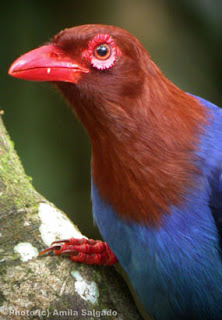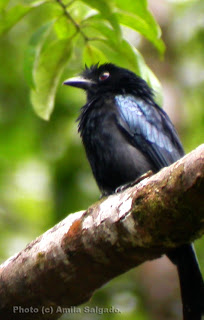
Ed and CJ, the British volunteers that I met during my trip to the SLWCS Field station in Wasgomuwa, booked a trip to Sinharaja rain forest with me from 13-15 Aug., 2007. After helping CJ to get her Sri Lankan visa extended in Colombo, we drove to Sinharaja, to reach there by late afternoon. It had rained a lot in the morning in Sinharaja, and all the streams were gushing in full strength. Luckily, when we started our 3km walk up to Martin’s Simple Lodge, our overnight accommodation, the weather remained bright and sunny.
Mentioning of our birding exploits, early on our walk, we encountered a nesting pair of Emerald Doves on a fern patch. As we were watching it in the scope, three Sri Lanka Blue Magpies came vying for our attention. These were accompanied by a similar number of Sri Lanka Grey Hornbills, the latter which was seen feeding on the fruits of Burulla plant (Leea indica). This was the first occasion that I saw these two species flocking together like this. We observed these two species moving together in another spot during same walk, probably consisting of the same individuals. As both are omnivorous (Sri Lanka Grey Hornbill is largely fruigivorous but turns to animal matter when feeding growing young and females imprisoned in nest cavities), I presume they may be extracting foraging benefits in locating food by feeding together.
In the study of mixed-species bird flocks, "a flock" is simply defined as "two or more species of birds moving in the same direction in search of food." And Sinharaja is the no.1 spot to observe mixed-species bird flocks in Sri Lanka.
Studied since 1981 (spearheaded by Prof. Sarath Kotagama of University of Colombo), Sinharaja’s mixed-species bird flock study is known to be the longest running such study in the world. So far fifty-nine species of birds have been found in the flocks, in addition to five mammal species, which follow the birds. Flocks average eleven species of birds and forty-one individual birds. During the months of October to April, several migrants, such as Asian Paradise Flycatcher and Chestnut-winged Crested Cuckoo (rare species) also join in, boosting the species-composition of the flock.
Orange-billed Babbler and Sri Lanka Crested Drongo (aka. Greater Racket-tailed Drongo), are jointly regarded as "nuclear species" of the flocks with presence of 92 and 89% respectively. The highly gregarious Orange-billed Babbler is the most numerically present bird in the flock with an average of 16 individual birds per flock; their frequent babbling calls often help birds, and birders to locate the bird flocks.

Flocks are formed mainly by the insectivorous birds in the rain forests to increase foraging efficiency, and to reduce the risk of predation. Accordingly, the insectivorous birds benefit by the "prey beating effect." This happens when a bird disturbs an insect while moving the forest in search of food. These disturbed insects are caught by the same bird or a lucky bird waiting nearby—which usually is a "hawking" species like a drongo.
As the birds usually occupy different levels (classified as emergent, canopy, sub-canopy, under storey and ground) in the complex rain forest structure, and employ various foraging methods in locating prey [gleaning, hawking, probing (wood), scratching (leaf littler)] such prey beating benefits one another.
Being in a mixed species bird flock helps birds to have a lot of eyes to scan for dangers and ensures "safety in numbers." Sri Lanka Crested Drongo, referred still by birding purists as Greater Racket-tailed Drongo, is nicknamed the "policeman" of the flock, is remarkable in this respect in giving alarm calls for other flock participants to evade danger and "mob" to drive potential predators away.
Sri Lanka Crested Drongo is also interesting in that it is capable of mimicking the calls, songs and alarm-associated calls of other birds. The first two call types mentioned are often used to good effect to draw birds towards the flocks. Dr. Eben Goodale and Prof. Sarath Kotagama, who have studied flocks for long, have shown that these drongos use alarm-associated calls of other birds in their own alarm vocalizations, while incorporating other species' songs and contact calls in their own songs; thus manifesting context specificity in their vocal mimicry.
According to the same study, these Drongos show an additional level of context specificity by mimicking other species' "ground predator-specific" call types when mobbing.
Click here to here to hear the ground predator-specific mobbing call of Orange-billed Babbler and here for the similar typed call of the Sri Lanka Scimitar Babbler and here for the same done by Ashy-headed laughingthrush and here for that of Sri Lanka Blue Magpie.

Now click here to hear these ground predator-specific mobbing calls being mimicked by the Sri Lanka Crested Drongo in a similar context together with its own ground-predator-specific mobbing calls!
I have often observed Sri Lanka Crested Drongo mimicking the calls of birds of prey such as Besra and Crested Goshawk (which almost exclusive prey on birds) and alarm calls of other flock participants to trigger panic and steal the food of other birds.
Such behaviour is termed kleptoparasitism and many drongo species are notorious for it. According to Harsha Sathischandra, who is carrying out a single-species study of this forest drongo, it also gives such false alarms when it is nesting in order to divert the flocks away from the next sites— probably in an attempt to protect its young from being preyed upon by some nest-predating birds such as the Green-billed Coucal and Sri Lanka Grey Blue Magpie that join the flocks, and other more dangerous birds of prey that may get attracted towards the flocks.
Drongos are known to give alarm calls that are more reliable than the other species in the flock. Therefore, the duping behaviour of drongos notwitstanding, other species gain real anti-predation benefits by joining the flocks.
Coming back to our tour, thanks to the rains in the morning, we encountered several good mixed-species bird flocks, which contained Orange-billed Babbler, Sri Lanka Crested Drongo, Red-faced Malkoha, Ashy-headed Laughing Thrush (with one flock containing 25 individuals), Malabar Trogon, White-faced Starling, and Sri Lanka Scimitar Babbler. A Layard’s Parakeet, a fruigivorous participant, was also seen in one of the flocks— feeding on the floral parts of the endemic pioneer, Kekiri-wara Schumacheria castaneifolia. This is not a rare sight as several other fruigivorous birds such as the endemic Yellow-fronted Barbet also show a regular presence in the bird flocks, probably deriving anti-predatory benifits.

A Square-tailed Black Bulbul was nagging, with its long-drawn nasal call, hinting distress. Moments later, it was seen chasing a Green-billed Coucal for several rounds in the undergrowth. Coucal is a notorious nest predator.
England finally redeemed some respect in the 4th in a series of Scrabble games played by beating Sri Lanka, but I came back to emerge victorious in the 5th and final game to finish our mini-series 4-1 in favour of Sri Lanka.
The above is my contribution to "I And The Bird" birding blog carnival #69 hosted by Living the Scientific Life






















1 comment:
Thank you! this helped a lot!
Post a Comment